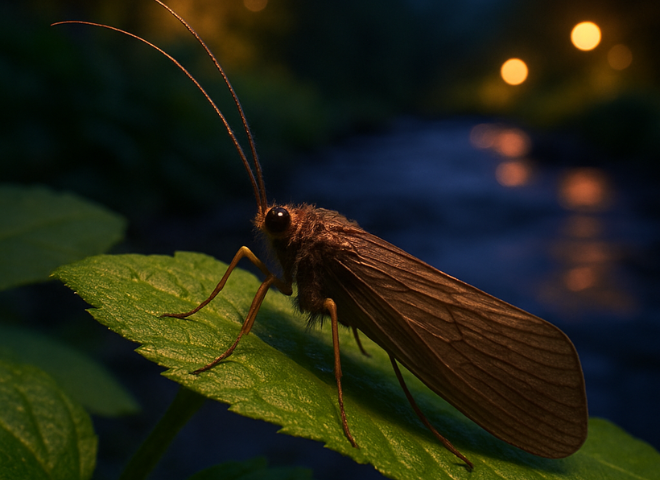Caddisflies, which fall under the order Trichoptera, are intriguing little insects. While adult caddisflies resemble moths and are mostly active at night, their aquatic larvae captivate scientists and nature lovers. Found in freshwater streams, ponds, and rivers, caddisfly larvae are nature’s underwater builders, constructing protective cases from natural materials like sand, pebbles, leaves, and twigs.
Unlike most insects, they don’t just manage to live in water—they prosper in it. As they are highly sensitive to pollution, their presence is typically a clear signal of clean water and a robust ecosystem.

How Do They Build Their Underwater Cases?
One of the most fascinating things about caddisfly larvae is their case-building behaviour. These structures protect while also blending into their surroundings. The larvae produce silk from glands near their mouths, which they use like glue to stick together:
- Sand grains
- Small stones
- Plant fragments
- Shells and other debris
The cases can exhibit various shapes, sizes, and structures, influenced by the specific species. This creative construction protects them from predators and anchors them in fast-moving water. Learn more about how caddisfly larvae construct their protective cases using natural materials in this detailed guide by the National Park Service.
Importance of Caddisflies in Ecosystems
Caddisflies play a crucial role in freshwater environments. Their contributions include:
- Breaking down organic matter
- Recycling nutrients in water bodies
- Supplying sustenance for fish, amphibians, and birds.
- Indicating clean, well-oxygenated water
Moreover, fly fishers often mimic caddisflies when designing artificial lures, especially for catching trout. This makes them both ecologically important and useful to humans.
Unveiling Their Essential Role
Fly fishermen love imitating caddisflies because:
- Fish Love Them! –Caddisfly larvae and adults are a top choice for trout, bass, and salmon.
- Innovative Hatch Design: Large clouds of adult caddisflies draw in hungry fish.
- Effective Lures: Artificial caddisfly flies (like the “Elk Hair Caddis”) are highly successful.
- Anglers often study caddisfly behaviour to improve their fishing strategies.
Are Caddisflies Harmful to Humans?
A common concern among people is whether caddisflies pose any threat to humans. The answer is no. These insects are completely harmless. They are harmless and pose no threat. Most people may never notice them unless they are near water sources during mating seasons, when adults are drawn to artificial lights.
Surprising Facts About Caddisflies You Might Not Know
- Some species use snail shells in their cases, creating jewellery-like patterns.
- Their silk is incredibly strong underwater and has inspired researchers in materials science.
- More than 14,500 species of caddisflies have been discovered across the globe.
- The larvae can thrive underwater for several months, while the adult stage is brief, lasting only a few days for mating and egg-laying
These insects are far more impressive than their tiny size suggests.
Pros and Cons of Caddisflies in Nature
Pros
- Indicators of clean and healthy water.
- Help decompose organic material naturally.
- Support aquatic and terrestrial food chains.
- Inspire scientific innovations in biomaterials.
CONS
- Adults can be attracted to lights in large numbers.
- May be mistaken for moths or pests indoors.
- Some species may damage aquatic plants.
- Cases may sometimes clog small filters.
As you can see, their pros significantly outweigh the cons, especially when considering their environmental role.
Final Thoughts
Caddisflies may be small, but they leave a big impact on the natural world. From cleaning freshwater ecosystems to inspiring scientific advancements, these tiny insects are much more than meets the eye. Their ability to transform everyday debris into protective homes is extraordinary. So next time you’re walking by a stream or pond, look closer—you might spot one of nature’s most fascinating underwater architects at work. Much like freshwater engineers like beavers, caddisflies transform their habitat in unexpected ways.”
Frequently Asked Queries
Q1: Where can caddisflies be found?
You can discover caddisflies thriving in diverse freshwater ecosystems worldwide, from streams and ponds to lakes and rivers.
Q2: How long do caddisflies live?
Underwater, larvae can persist for several months, but adult insects usually only last a few days, primarily to mate.
Q3: Can caddisflies survive in polluted water?
These organisms depend on pristine, well-oxygenated water, positioning them as key pollution indicators.
Q4: What do caddisfly larvae eat?
Most larvae thrive on rotting plant matter, algae, or microorganisms, depending on their specific type.
Q5: Can I see a caddisfly in my backyard pond?
If your pond has clean, well-oxygenated water, there’s a good chance caddisfly larvae could be living there.
Source: https://www.nps.gov/romo/caddisflies.htm
Have you seen a caddisfly or their cases in the wild? Share your experience in the comments.

I am extremely impressed along with your writing talents
and also with the format on your blog. Is
this a paid subject or did you customize it yourself? Either way keep up the excellent high quality writing, it’s uncommon to see a nice
weblog like this one nowadays. Beacons AI!
It was written by me brother